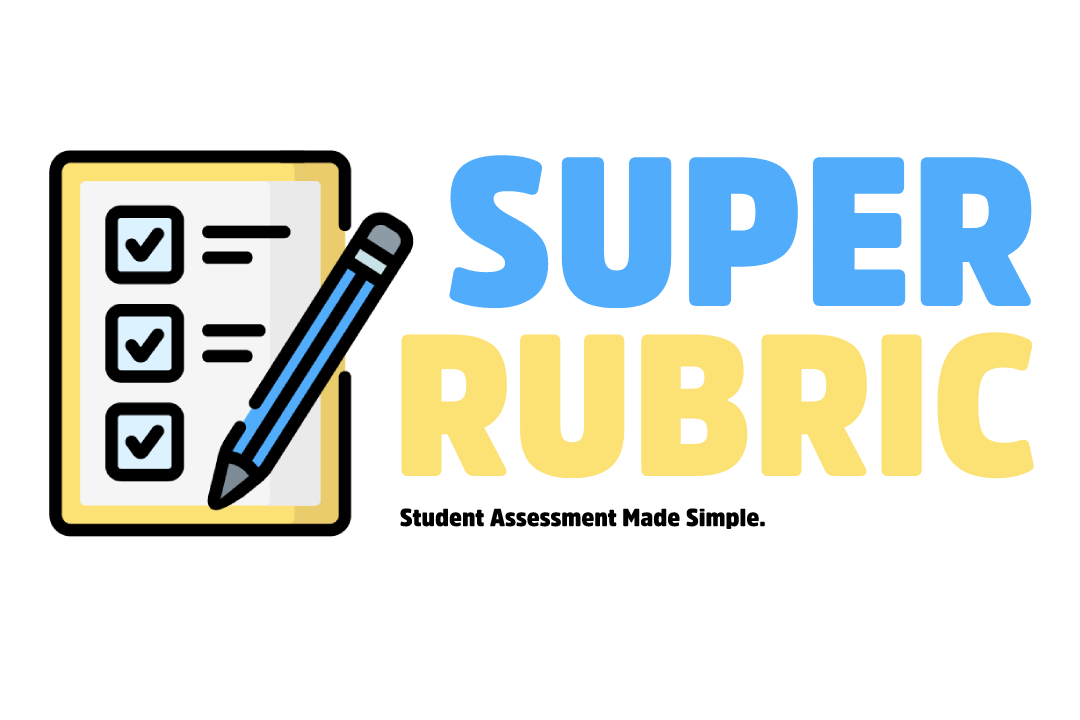
- Gradebook App
- Student Reports
- Training & Consulting
- Literacy Booster Offer
- Subscription Pricing
- Professional Development
- Our Mission
- Case Studies
- Privacy Policy & Terms of Service
- Review Mode


Mastering The Rubric for Book Report: Your Comprehensive Guide
As educators, we know that book reports play a crucial role in cultivating a love for reading and nurturing critical thinking skills in students. However, crafting effective book reports that engage and challenge students can be quite a task. That’s why we’re here to assist you with a rubric for book report!
In this blog post, we will provide you with a comprehensive rubric guide tailored to teachers, helping you create impactful book report assessments. Let’s dive in and discover the secrets to mastering the art of book reports!
I. Understanding the Purpose of Book Reports
Before we delve into the nitty-gritty of rubrics, let’s clarify the purpose of book reports. Book reports serve multiple functions, including assessing comprehension, encouraging reflection, promoting analytical thinking, and fostering creativity.
A well-designed book report prompts students to analyze characters, plotlines, themes, and literary devices, and express their thoughts and opinions in a structured manner.
By using rubrics, you can provide clear guidelines and expectations, allowing students to understand the criteria for assessment. A central focus of the book report will be helping students to understand the rubric for book report.
II. Key Elements, Rubric for Book Report
A book report rubric is a powerful tool that helps you evaluate your students’ work consistently and fairly. It provides a framework for assessing various aspects of their book reports, including the following key elements:
- Book Summary: Assess how effectively students summarize the main plot points , key events, and significant details of the book. Look for concise and accurate summaries that capture the essence of the story.
- Critical Assessment of Text: Evaluate students’ ability to analyze and evaluate the book’s strengths, weaknesses, and overall literary merit. Look for insightful observations and evidence of critical thinking.
- Presentation of Ideas: Consider the organization and coherence of students’ ideas and arguments. Look for a logical flow of thoughts, well-structured paragraphs, and effective use of supporting evidence.
- Use of Language and Conventions: Evaluate students’ language proficiency , grammar, punctuation, and overall writing mechanics. Look for clear communication and adherence to language conventions.
- Word Choice : Assess students’ vocabulary usage and their ability to select appropriate words to convey meaning effectively. Look for varied and precise word choices that enhance the quality of their writing.
III. Creating an Effective Rubric for Book Report
Now that we understand the key elements, let’s explore how to create an effective rubric for book report. Remember, the rubric should be clear, concise, and easy to understand. Here are some steps to guide you:
- Define your criteria: Clearly define the assessment criteria , including book summary, critical assessment of text, presentation of ideas, use of language and conventions, and word choice.
- Determine levels of performance: Create a scale that reflects various levels of achievement, such as excellent, proficient, developing, or needs improvement. Ensure that each level has clear descriptors specific to each criterion.
- Assign point values: Allocate points to each criterion based on its importance and weight in the overall assessment. This helps provide a fair evaluation and offers students a clear understanding of their performance.
- Communicate expectations: Share the rubric with your students, explaining the criteria, levels of performance, and point values. This will enhance their understanding and enable self-assessment and improvement.
IV. The Benefits of Using Rubrics for Book Reports
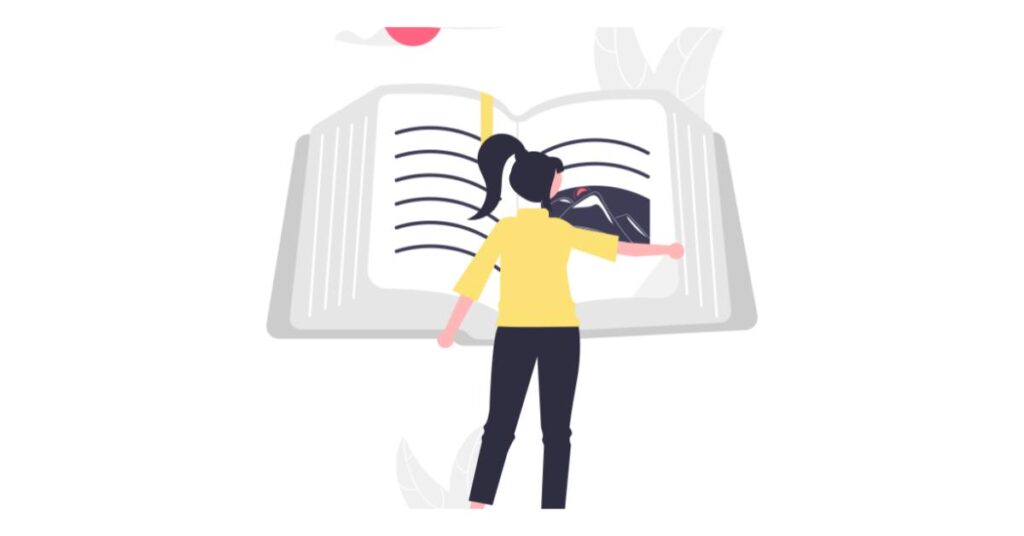
- Clarity and fairness: The rubric for book report will provide explicit guidelines, leaving no room for ambiguity. Students understand exactly what is expected, and you can ensure consistent and fair evaluation.
- Self-assessment and reflection: Rubrics empower students to assess their own work, fostering metacognitive skills and encouraging reflection on their strengths and areas for improvement .
- Targeted feedback: With a rubric, you can provide specific and actionable feedback. Students can see which criteria they excelled in and which ones require more attention, enabling focused growth.
- Goal setting and improvement: Rubrics help students set goals for future assignments and track their progress. By understanding the criteria and levels of performance, they can strive for continuous improvement.
Ready to simplify your rubric for book reports? Try our Rubric Maker today and streamline the process! Create custom rubrics tailored to your specific requirements, focusing on book summary, critical assessment of text, presentation of ideas, use of language and conventions, and word choice.
With our Rubric Maker , you can save time grading, provide clear expectations to your students, and foster their growth as analytical thinkers and skilled communicators. Visit [your website] now and revolutionize your book report assessments!
Conclusion: Rubric for Book Report
Mastering the art of book reports is no longer an overwhelming task. By utilizing a well-designed rubric that incorporates book summary, critical assessment of text, presentation of ideas, use of language and conventions, and word choice, you can create engaging assessments that foster critical thinking and effective communication.
Rubrics provide clarity, fairness, and targeted feedback, benefiting both you and your students. So, take the leap, try our Rubric Maker, and witness the positive impact it will have on your students’ book report journey. Happy assessing and happy reading!
Use the Book Report Rubric Now!
Recent Posts
Report card writing made simple.
- Executive Functioning Rubrics are a Game Changer
The Teacher’s Guide to Mastering Orthographic Mapping
Can rubrics help with executive functioning skills.
- 5 Rubrics for Differentiated Instruction
Recent Comments
- 5 Reasons Teachers Love Analytical Rubrics - SUPERRUBRIC - SUPERRUBRIC.COM on 3 Rubrics for Elementary Reading & Writing
- A WordPress Commenter on Discussion Forum Rubric – Free Rubric Maker
Trending Now
- Book Report Rubric – Free Rubric Maker September 19, 2022
- Discussion Forum Rubric – Free Rubric Maker March 18, 2021
- 3 Rubrics for Elementary School [Analytic Rubrics] November 6, 2022
Recently Posted

How to Write a Book Report
Use the links below to jump directly to any section of this guide:
Book Report Fundamentals
Preparing to write, an overview of the book report format, how to write the main body of a book report, how to write a conclusion to a book report, reading comprehension and book reports, book report resources for teachers .
Book reports remain a key educational assessment tool from elementary school through college. Sitting down to close read and critique texts for their content and form is a lifelong skill, one that benefits all of us well beyond our school years. With the help of this guide, you’ll develop your reading comprehension and note-taking skills. You’ll also find resources to guide you through the process of writing a book report, step-by-step, from choosing a book and reading actively to revising your work. Resources for teachers are also included, from creative assignment ideas to sample rubrics.
Book reports follow general rules for composition, yet are distinct from other types of writing assignments. Central to book reports are plot summaries, analyses of characters and themes, and concluding opinions. This format differs from an argumentative essay or critical research paper, in which impartiality and objectivity is encouraged. Differences also exist between book reports and book reviews, who do not share the same intent and audience. Here, you’ll learn the basics of what a book report is and is not.
What Is a Book Report?
"Book Report" ( ThoughtCo )
This article, written by a professor emeritus of rhetoric and English, describes the defining characteristics of book reports and offers observations on how they are composed.
"Writing a Book Report" (Purdue OWL)
Purdue’s Online Writing Lab outlines the steps in writing a book report, from keeping track of major characters as you read to providing adequate summary material.
"How to Write a Book Report" ( Your Dictionary )
This article provides another helpful guide to writing a book report, offering suggestions on taking notes and writing an outline before drafting.
"How to Write a Successful Book Report" ( ThoughtCo )
Another post from ThoughtCo., this article highlights the ten steps for book report success. It was written by an academic advisor and college enrollment counselor.
What’s the Difference Between a Book Report and an Essay?
"Differences Between a Book Report & Essay Writing" ( Classroom)
In this article from the education resource Classroom, you'll learn the differences and similarities between book reports and essay writing.
"Differences Between a Book Report and Essay Writing" (SeattlePi.com)
In this post from a Seattle newspaper's website, memoirist Christopher Cascio highlights how book report and essay writing differ.
"The Difference Between Essays and Reports" (Solent Online Learning)
This PDF from Southampton Solent University includes a chart demonstrating the differences between essays and reports. Though it is geared toward university students, it will help students of all levels understand the differing purposes of reports and analytical essays.
What’s the Difference Between a Book Report and a Book Review?
"How to Write a Book Review and a Book Report" (Concordia Univ.)
The library at Concordia University offers this helpful guide to writing book report and book reviews. It defines differences between the two, then presents components that both forms share.
"Book Reviews" (Univ. of North Carolina)
The University of North Carolina at Chapel Hill’s writing guide shows the step-by-step process of writing book reviews, offering a contrast to the composition of book reports.
Active reading and thoughtful preparation before you begin your book report are necessary components of crafting a successful piece of writing. Here, you’ll find tips and resources to help you learn how to select the right book, decide which format is best for your report, and outline your main points.
Selecting and Finding a Book
"30 Best Books for Elementary Readers" (Education.com)
This article from Education.com lists 30 engaging books for students from kindergarten through fifth grade. It was written by Esme Raji Codell, a teacher, author, and children's literature specialist.
"How to Choose a Good Book for a Report (Middle School)" (WikiHow)
This WikiHow article offers suggestions for middle schoolers on how to choose the right book for a report, from getting started early on the search process to making sure you understand the assignment's requirements.
"Best Book-Report Books for Middle Schoolers" (Common Sense Media)
Common Sense Media has compiled this list of 25 of the best books for middle school book reports. For younger students, the article suggests you check out the site's "50 Books All Kids Should Read Before They're 12."
"50 Books to Read in High School" (Lexington Public Library)
The Lexington, Kentucky Public Library has prepared this list to inspire high school students to choose the right book. It includes both classics and more modern favorites.
The Online Computer Library Center's catalogue helps you locate books in libraries near you, having itemized the collections of 72,000 libraries in 170 countries.
Formats of Book Reports
"Format for Writing a Book Report" ( Your Dictionary )
Here, Your Dictionary supplies guidelines for the basic book report format. It describes what you'll want to include in the heading, and what information to include in the introductory paragraph. Be sure to check these guidelines against your teacher's requirements.
"The Good Old Book Report" (Scholastic)
Nancy Barile’s blog post for Scholastic lists the questions students from middle through high school should address in their book reports.
How to Write an Outline
"Writer’s Web: Creating Outlines" (Univ. of Richmond)
The University of Richmond’s Writing Center shows how you can make use of micro and macro outlines to organize your argument.
"Why and How to Create a Useful Outline" (Purdue OWL)
Purdue’s Online Writing Lab demonstrates how outlines can help you organize your report, then teaches you how to create outlines.
"Creating an Outline" (EasyBib)
EasyBib, a website that generates bibliographies, offers sample outlines and tips for creating your own. The article encourages you to think about transitions and grouping your notes.
"How to Write an Outline: 4 Ways to Organize Your Thoughts" (Grammarly)
This blog post from a professional writer explains the advantages of using an outline, and presents different ways to gather your thoughts before writing.
In this section, you’ll find resources that offer an overview of how to write a book report, including first steps in preparing the introduction. A good book report's introduction hooks the reader with strong opening sentences and provides a preview of where the report is going.
"Step-by-Step Outline for a Book Report" ( Classroom )
This article from Classroom furnishes students with a guide to the stages of writing a book report, from writing the rough draft to revising.
"Your Roadmap to a Better Book Report" ( Time4Writing )
Time4Writing offers tips for outlining your book report, and describes all of the information that the introduction, body, and conclusion should include.
"How to Start a Book Report" ( ThoughtCo)
This ThoughtCo. post, another by academic advisor and college enrollment counselor Grace Fleming, demonstrates how to write a pithy introduction to your book report.
"How to Write an Introduction for a Book Report" ( Classroom )
This brief but helpful post from Classroom details what makes a good book report introduction, down to the level of individual sentences.
The body paragraphs of your book report accomplish several goals: they describe the plot, delve more deeply into the characters and themes that make the book unique, and include quotations and examples from the book. Below are some resources to help you succeed in summarizing and analyzing your chosen text.
Plot Summary and Description
"How Do You Write a Plot Summary?" ( Reference )
This short article presents the goals of writing a plot summary, and suggests a word limit. It emphasizes that you should stick to the main points and avoid including too many specific details, such as what a particular character wears.
"How to Write a Plot for a Book Report" ( The Pen & The Pad )
In this article from a resource website for writers, Patricia Harrelson outlines what information to include in a plot summary for a book report.
"How to Write a Book Summary" (WikiHow)
Using Harry Potter and the Sorcerer’s Stone as an example, this WikiHow article demonstrates how to write a plot summary one step at a time.
Analyzing Characters and Themes
"How to Write a Character Analysis Book Report" ( The Pen & The Pad )
Kristine Tucker shows how to write a book report focusing on character. You can take her suggestions as they are, or consider incorporating them into the more traditional book report format.
"How to Write a Character Analysis" (YouTube)
The SixMinuteScholar Channel utilizes analysis of the film Finding Nemo to show you how to delve deeply into character, prioritizing inference over judgment.
"How to Define Theme" ( The Editor's Blog )
Fiction editor Beth Hill contributes an extended definition of theme. She also provides examples of common themes, such as "life is fragile."
"How to Find the Theme of a Book or Short Story" ( ThoughtCo )
This blog post from ThoughtCo. clarifies the definition of theme in relation to symbolism, plot, and moral. It also offers examples of themes in literature, such as love, death, and good vs. evil.
Selecting and Integrating Quotations
"How to Choose and Use Quotations" (Santa Barbara City College)
This guide from a college writing center will help you choose which quotations to use in your book report, and how to blend quotations with your own words.
"Guidelines for Incorporating Quotes" (Ashford Univ.)
This PDF from Ashford University's Writing Center introduces the ICE method for incorporating quotations: introduce, cite, explain.
"Quote Integration" (YouTube)
This video from The Write Way YouTube channel illustrates how to integrate quotations into writing, and also explains how to cite those quotations.
"Using Literary Quotations" (Univ. of Wisconsin-Madison)
This guide from the University of Wisconsin-Madison’s Writing Center helps you emphasize your analysis of a quotation, and explains how to incorporate quotations into your text.
Conclusions to any type of paper are notoriously tricky to write. Here, you’ll learn some creative ways to tie up loose ends in your report and express your own opinion of the book you read. This open space for sharing opinions that are not grounded in critical research is an element that often distinguishes book reports from other types of writing.
"How to Write a Conclusion for a Book Report" ( Classroom )
This brief article from the education resource Classroom illustrates the essential points you should make in a book report conclusion.
"Conclusions" (Univ. of North Carolina)
The University of North Carolina at Chapel Hill’s Writing Center lays out strategies for writing effective conclusions. Though the article is geared toward analytical essay conclusions, the tips offered here will also help you write a strong book report.
"Ending the Essay: Conclusions" (Harvard College Writing Center)
Pat Bellanca’s article for Harvard University’s Writing Center presents ways to conclude essays, along with tips. Again, these are suggestions for concluding analytical essays that can also be used to tie up a book report's loose ends.
Reading closely and in an engaged manner is the strong foundation upon which all good book reports are built. The resources below will give you a picture of what active reading looks like, and offer strategies to assess and improve your reading comprehension. Further, you’ll learn how to take notes—or “annotate” your text—making it easier to find important information as you write.
How to Be an Active Reader
"Active Reading Strategies: Remember and Analyze What You Read" (Princeton Univ.)
Princeton University’s McGraw Center for Teaching and Learning recommends ten strategies for active reading, and includes sample diagrams.
"Active Reading" (Open Univ.)
The Open University offers these techniques for reading actively alongside video examples. The author emphasizes that you should read for comprehension—not simply to finish the book as quickly as possible.
"7 Active Reading Strategies for Students" ( ThoughtCo )
In this post, Grace Fleming outlines seven methods for active reading. Her suggestions include identifying unfamiliar words and finding the main idea.
"5 Active Reading Strategies for Textbook Assignments" (YouTube)
Thomas Frank’s seven-minute video demonstrates how you can retain the most important information from long and dense reading material.
Assessing Your Reading Comprehension
"Macmillan Readers Level Test" (MacMillan)
Take this online, interactive test from a publishing company to find out your reading level. You'll be asked a number of questions related to grammar and vocabulary.
"Reading Comprehension Practice Test" (ACCUPLACER)
ACCUPLACER is a placement test from The College Board. This 20-question practice test will help you see what information you retain after reading short passages.
"Reading Comprehension" ( English Maven )
The English Maven site has aggregated exercises and tests at various reading levels so you can quiz your reading comprehension skills.
How to Improve Your Reading Comprehension
"5 Tips for Improving Reading Comprehension" ( ThoughtCo )
ThoughtCo. recommends five tips to increase your reading comprehension ability, including reading with tools such as highlighters, and developing new vocabulary.
"How to Improve Reading Comprehension: 8 Expert Tips" (PrepScholar)
This blog post from PrepScholar provides ideas for improving your reading comprehension, from expanding your vocabulary to discussing texts with friends.
CrashCourse video: "Reading Assignments" (YouTube)
This CrashCourse video equips you with tools to read more effectively. It will help you determine how much material you need to read, and what strategies you can use to absorb what you read.
"Improving Reading Comprehension" ( Education Corner )
From a pre-reading survey through post-reading review, Education Corner walks you through steps to improve reading comprehension.
Methods of In-text Annotation
"The Writing Process: Annotating a Text" (Hunter College)
This article from Hunter College’s Rockowitz Writing Center outlines how to take notes on a text and provides samples of annotation.
"How To Annotate Text While Reading" (YouTube)
This video from the SchoolHabits YouTube channel presents eleven annotation techniques you can use for better reading comprehension.
"5 Ways To Annotate Your Books" ( Book Riot )
This article from the Book Riot blog highlights five efficient annotation methods that will save you time and protect your books from becoming cluttered with unnecessary markings.
"How Do You Annotate Your Books?" ( Epic Reads )
This post from Epic Reads highlights how different annotation methods work for different people, and showcases classic methods from sticky notes to keeping a reading notebook.
Students at every grade level can benefit from writing book reports, which sharpen critical reading skills. Here, we've aggregated sources to help you plan book report assignments and develop rubrics for written and oral book reports. You’ll also find alternative book report assessment ideas that move beyond the traditional formats.
Teaching Elementary School Students How to Write Book Reports
"Book Reports" ( Unique Teaching Resources )
These reading templates courtesy of Unique Teaching Resources make great visual aids for elementary school students writing their first book reports.
"Elementary Level Book Report Template" ( Teach Beside Me )
This printable book report template from a teacher-turned-homeschooler is simple, classic, and effective. It asks basic questions, such as "who are the main characters?" and "how did you feel about the main characters?"
"Book Reports" ( ABC Teach )
ABC Teach ’s resource directory includes printables for book reports on various subjects at different grade levels, such as a middle school biography book report form and a "retelling a story" elementary book report template.
"Reading Worksheets" ( Busy Teacher's Cafe )
This page from Busy Teachers’ Cafe contains book report templates alongside reading comprehension and other language arts worksheets.
Teaching Middle School and High School Students How to Write Book Reports
"How to Write a Book Report: Middle and High School Level" ( Fact Monster)
Fact Monster ’s Homework Center discusses each section of a book report, and explains how to evaluate and analyze books based on genre for students in middle and high school.
"Middle School Outline Template for Book Report" (Trinity Catholic School)
This PDF outline template breaks the book report down into manageable sections for seventh and eighth graders by asking for specific information in each paragraph.
"Forms for Writing a Book Report for High School" ( Classroom )
In this article for Classroom, Elizabeth Thomas describes what content high schoolers should focus on when writing their book reports.
"Forms for Writing a Book Report for High School" ( The Pen & The Pad )
Kori Morgan outlines techniques for adapting the book report assignment to the high school level in this post for The Pen & The Pad .
"High School Book Lists and Report Guidelines" (Highland Hall Waldorf School)
These sample report formats, grading paradigms, and tips are collected by Highland Hall Waldorf School. Attached are book lists by high school grade level.

Sample Rubrics
"Book Review Rubric Editable" (Teachers Pay Teachers)
This free resource from Teachers Pay Teachers allows you to edit your book report rubric to the specifications of your assignment and the grade level you teach.
"Book Review Rubric" (Winton Woods)
This PDF rubric from a city school district includes directions to take the assignment long-term, with follow-up exercises through school quarters.
"Multimedia Book Report Rubric" ( Midlink Magazine )
Perfect for oral book reports, this PDF rubric from North Carolina State University's Midlink Magazine will help you evaluate your students’ spoken presentations.
Creative Book Report Assignments
"25 Book Report Alternatives" (Scholastic)
This article from the Scholastic website lists creative alternatives to the standard book report for pre-kindergarteners through high schoolers.
"Fresh Ideas for Creative Book Reports" ( Education World )
Education World offers nearly 50 alternative book report ideas in this article, from a book report sandwich to a character trait diagram.
"A Dozen Ways to Make Amazingly Creative Book Reports" ( We Are Teachers )
This post from We Are Teachers puts the spotlight on integrating visual arts into literary study through multimedia book report ideas.
"More Ideas Than You’ll Ever Use for Book Reports" (Teachnet.com)
This list from Teachnet.com includes over 300 ideas for book report assignments, from "interviewing" a character to preparing a travel brochure to the location in which the book is set.
"Fifty Alternatives to the Book Report" (National Council of Teachers of English)
In this PDF resource from the NCTE's English Journal, Diana Mitchell offers assignment ideas ranging from character astrology signs to a character alphabet.
- PDFs for all 136 Lit Terms we cover
- Downloads of 1900 LitCharts Lit Guides
- Teacher Editions for every Lit Guide
- Explanations and citation info for 39,983 quotes across 1900 books
- Downloadable (PDF) line-by-line translations of every Shakespeare play
Need something? Request a new guide .
How can we improve? Share feedback .
LitCharts is hiring!

- Grades 6-12
- School Leaders
FREE Poetry Worksheet Bundle! Perfect for National Poetry Month.
Free Book Report Templates: Printables for Grades 3-5 for Fiction or Nonfiction Books
Take a new spin on your book report assignment. 📚😍
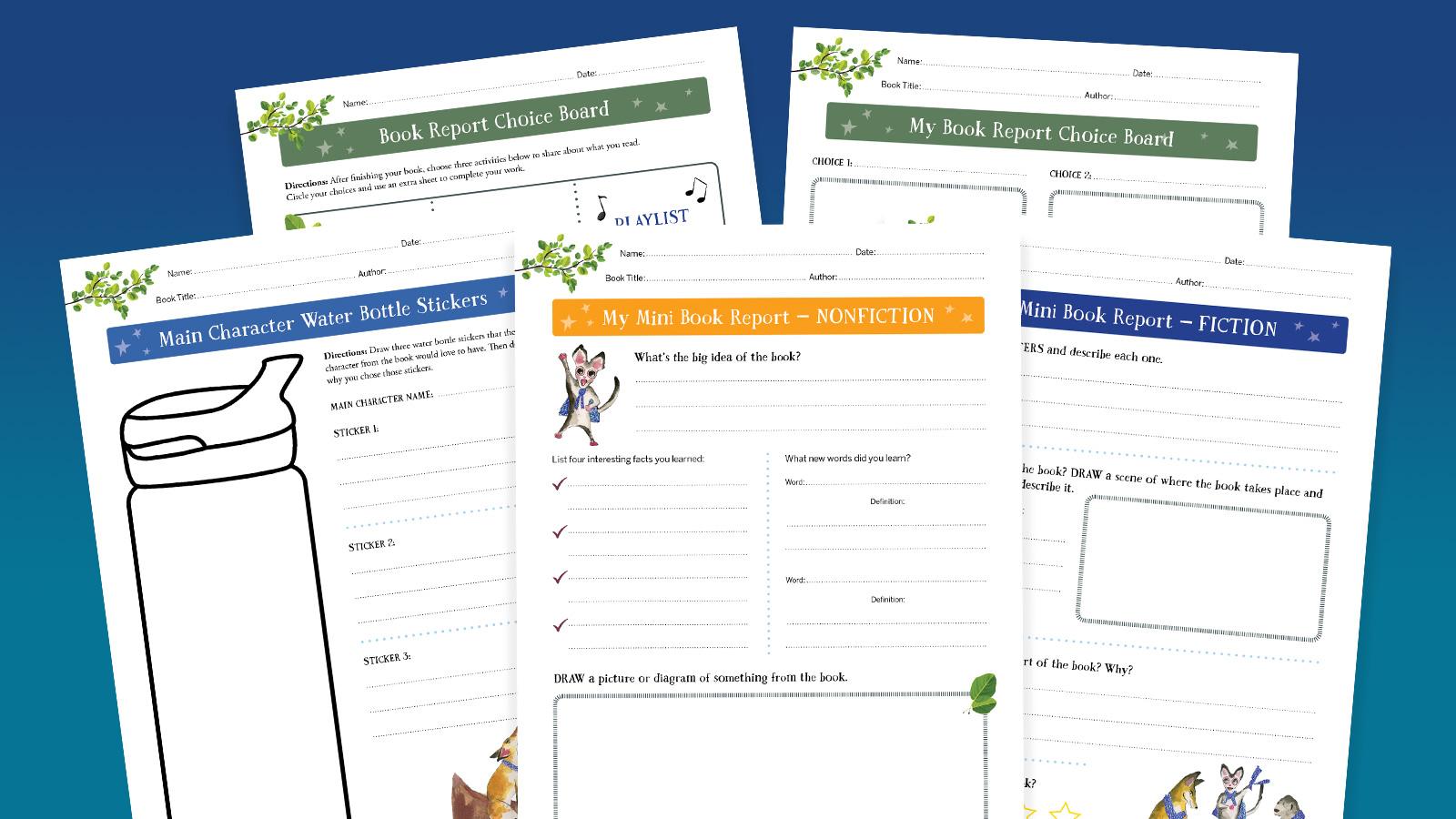
The Nocturnals are fun-filled animal adventure books with companion nonfiction for elementary school classrooms. Check out The Nocturnals World , a resource hub with free turnkey printable activities and educator guides, and browse The Nocturnals bookstore!
Building lifelong readers is one of the most important things we can do in our classrooms. The benefits of reading are wide-ranging, from improving vocabulary skills to boosting cognitive development, concentration skills, and curiosity for learning. So, how do we get young learners excited about reading and sharing what they’ve learned? Check out our free book report template printables .
Four different activities are ready to print to help you take a new spin on your next book report assignment for fiction or nonfiction books. Students will love filling in their mini book report one-pagers or making their selections from the choice board to share details about what they read.
Worksheets Included:
My mini book report—fiction and nonfiction.
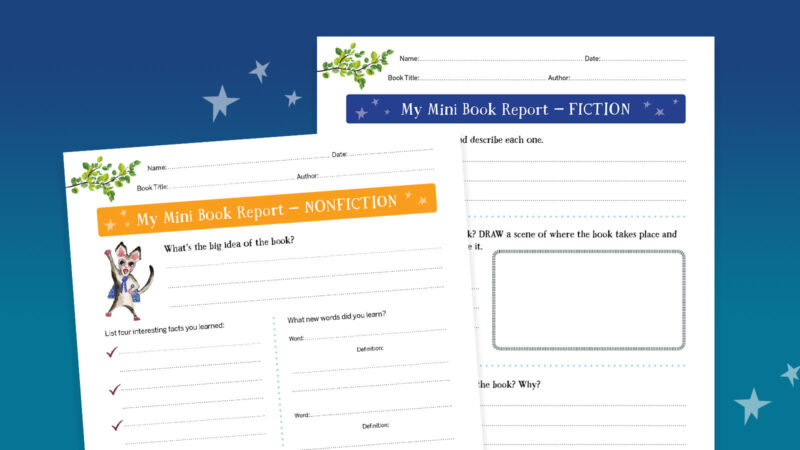
These book report one-pagers are a great way for students to reflect on their readings as they complete different sections of the worksheet. There’s a version for both fiction and nonfiction.
Book Report Choice Board
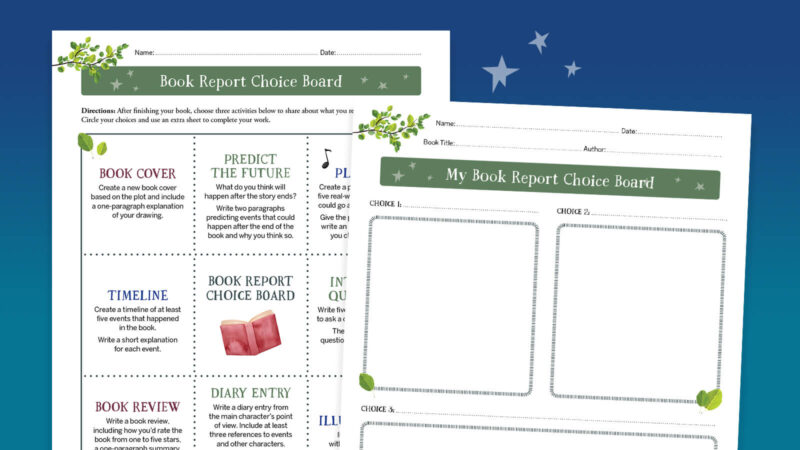
Give students choices on how they want to complete their book report assignment. This choice board offers eight fun options, from designing a comic to creating a playlist or writing interview questions, so students can let their creativity guide them.
Designing Water Bottle Stickers
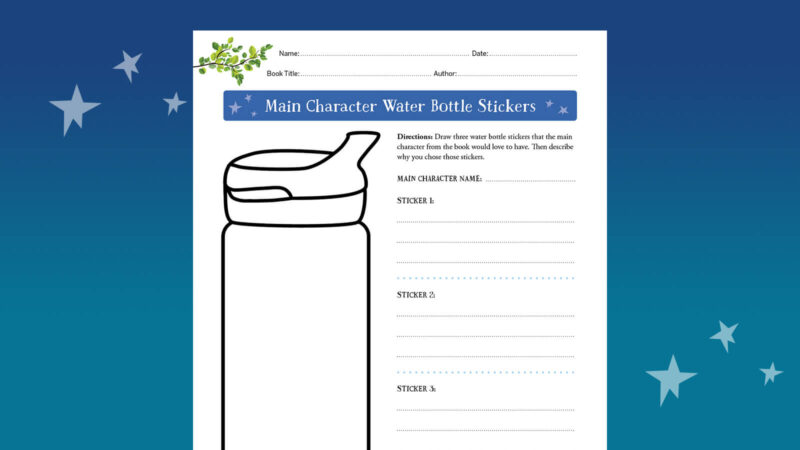
Students are obsessed with stickers. In this unique activity, students will design water bottle stickers that the main character of the book would love to have, along with a short description of their choices.
Give students fun-filled books to choose from
Animal adventure books from The Nocturnals are the perfect way to get your upper elementary students excited about reading. Paired with nonfiction companion texts that explore nocturnal animal facts, this series is great for hi-lo readers. Visit The Nocturnals World for more free printable activities and educator guides.
You Might Also Like
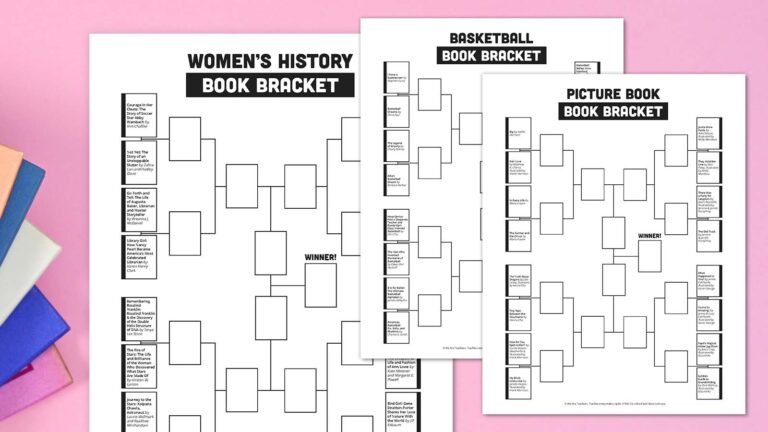
Book Bracket Template: Free Download for March Madness and Beyond
It's a battle of the books! Continue Reading
Copyright © 2023. All rights reserved. 5335 Gate Parkway, Jacksonville, FL 32256
Book Report Alternative: Glog That Book!
- Resources & Preparation
- Instructional Plan
- Related Resources
In this lesson, students review the elements of fiction. They identify and share these components by creating unique glogs, which are interactive multimedia posters, through Glogster EDU . This activity offers an alternative to the traditional book report as well as an opportunity for students to share their glogs with their classmates, who will have suggestions of what they might enjoy reading next from viewing each other's glogs.
Featured Resources
- Book Report Glog : Students use this planning sheet to think through the elements of their glog before they work on computers.
- Glogster EDU : Students' glogs will be created on this website.
From Theory to Practice
Without a doubt, all students should be able to read and communicate effectively with others what they have read. Nolan explains that using technology in the classroom offers opportunities for developing necessary skills such as reading, writing, communicating, and questioning. She writes, “technology creates opportunities for students to explore, try different tactics, and exercise increments of freedom.”
In this lesson, technology meshes with the book report to provide students a creative opportunity. It addresses the problem that Mitchell identifies: “Students tire of responding to novels in the same ways. They want new ways to think about a piece of literature and new ways to dig into it.”
Further Reading
Nolan, Sara. “ How Technology Fuels Learning .” MindShift Blog, KQED.org. September 16,2011.
Common Core Standards
This resource has been aligned to the Common Core State Standards for states in which they have been adopted. If a state does not appear in the drop-down, CCSS alignments are forthcoming.
State Standards
This lesson has been aligned to standards in the following states. If a state does not appear in the drop-down, standard alignments are not currently available for that state.
NCTE/IRA National Standards for the English Language Arts
- 1. Students read a wide range of print and nonprint texts to build an understanding of texts, of themselves, and of the cultures of the United States and the world; to acquire new information; to respond to the needs and demands of society and the workplace; and for personal fulfillment. Among these texts are fiction and nonfiction, classic and contemporary works.
- 2. Students read a wide range of literature from many periods in many genres to build an understanding of the many dimensions (e.g., philosophical, ethical, aesthetic) of human experience.
- 3. Students apply a wide range of strategies to comprehend, interpret, evaluate, and appreciate texts. They draw on their prior experience, their interactions with other readers and writers, their knowledge of word meaning and of other texts, their word identification strategies, and their understanding of textual features (e.g., sound-letter correspondence, sentence structure, context, graphics).
- 6. Students apply knowledge of language structure, language conventions (e.g., spelling and punctuation), media techniques, figurative language, and genre to create, critique, and discuss print and nonprint texts.
- 8. Students use a variety of technological and information resources (e.g., libraries, databases, computer networks, video) to gather and synthesize information and to create and communicate knowledge.
- 11. Students participate as knowledgeable, reflective, creative, and critical members of a variety of literacy communities.
- 12. Students use spoken, written, and visual language to accomplish their own purposes (e.g., for learning, enjoyment, persuasion, and the exchange of information).
Materials and Technology
- Computers with Internet capabilities
- LCD projector, overhead projector, and/or interactive whiteboard
- Book Report Glog
- Book Report Glog Rubric
This website provides educators the software to create glogs. For a small yearly charge, a teacher can receive fifty accounts. Additionally, it offers educators two yearly schoolwide subscription levels that allows for extra features that are not used in this project but would be useful in other projects.
This site offers several sound effects that can be downloaded without cost.
Preparation
- Before this lesson, have students read a fiction book independently.
- Ask students to bring copies of their books that will be the focus of their glogs to class for reference.
- Review the definitions of the literary terms used in the glog: protagonist setting, conflict, resolution, theme, climax, point of view, characterization, and genre.
- Using examples from stories students have previously read together, apply the literary terms.
- Reserve time in your school’s computer lab for use while students are creating their glogs.
- Sign up for an account at Glogster EDU and request the number of student accounts you need. You can have up to fifty accounts. Glogster will generate user names and passwords for your student accounts. Assign each student an account.
- Make copies of Glog It! , Book Report Glog , and Book Report Glog Rubric (one for each student).
- Become familiar with Glogster . Practice the steps of making a glog using Glog It! . Create a sample glog using a story that students have read together previously. You can find samples of other book report glogs under Categories at Glogster EDU under English and Language Arts or Reading.
- Find sources for sound and video that are appropriate for your class.
Student Objectives
Students will:
- identify elements of fiction.
- analyze a fiction book.
- communicate literary terms in visual and written form by producing a glog.
- celebrate reading by sharing their glogs with their classmates.
Session One: Introducing the Project
- Show the sample glog of the story that students have previously read together.
- Go through the rubric and grade the sample glog as a class. Discuss how the two quotes reflect the essence of the story. Discuss how the hyperlinks expand topics that are in the book, for example, links to author’s homepage or topics covered in the book.
- Give each student the printout Book Report Glog .
- Assign students to complete the printout before the next session.
Sessions Two through Four: Creating the Glog
- Check the students have completed the Book Report Glog .
- Model each step of creating a glog using the printout Glog It! .
- Provide each student with his/her username and password. When the student signs in for the first time, the student will be asked to type in his/her name. Instruct the students to do so because then you will be able to see on your teacher dashboard the students by name and username.
- Check on their accuracy of use of literary terms and help students revise where needed.
- Question students about which quotes they have selected from their books and why these quotes reflect the essence of the book.
- Ask students what hyperlinks they have selected and why their links are good, credible websites.
- Also, ask students how the sounds, images, and videos they have chosen relate to their books so that the students make the glogs truly reflect their books.
- Encourage students to work on their glogs from any computer (home or public library, for example) since this is an Internet-based program.
Session Five: Celebrating and Sharing
- Celebrate the joy of reading by having each student share his/her glog with the class. From the teacher’s dashboard in Glogster , each student’s glog can be easily accessed so that each student does not have to log-in before each presentation.
- As students present their glogs, students can use the rubric to assess their peers and/or the teacher can use this time to assess the glog using the rubric .
- Establish a class wiki and post links to the glogs to the wiki. Publish your classroom wiki to the community, so the audience for your student is larger.
- Add other literary terms to the glog, such as plot, antagonist, foreshadowing, etc.
Student Assessment / Reflections
- Before students work on their glogs, review each student’s completed Book Report Glog checklist .
- During each session, observe and note the students’ time on task as this is one of the categories on the rubric . Using the Book Report Glog Rubric , evaluate each student’s completed glog. Offer feed back to the students on their glogs.
- Have students present their glogs to the class. Question students about their choices of quotes, pictures, videos, and sounds to show the essence of their books. Use the rubric to assess students' final projects.
- Professional Library
- Lesson Plans
Add new comment
- Print this resource
Explore Resources by Grade
- Kindergarten K
Book Review Rubric Editable (FREE)
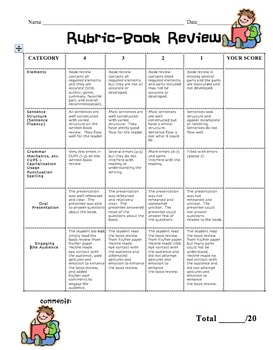
- Word Document File
Description
Questions & answers, fourth grade flipper.
- We're hiring
- Help & FAQ
- Privacy policy
- Student privacy
- Terms of service
- Tell us what you think
- help_outline help
iRubric: 5th Grade Biography Book Report rubric
Customer Reviews
John N. Williams
Research papers can be complex, so best to give our essay writing service a bit more time on this one. Luckily, a longer paper means you get a bigger discount!
Emery Evans

Finished Papers
Sophia Melo Gomes
Customer Reviews
Well-planned online essay writing assistance by PenMyPaper
Writing my essays has long been a part and parcel of our lives but as we grow older, we enter the stage of drawing critical analysis of the subjects in the writings. This requires a lot of hard work, which includes extensive research to be done before you start drafting. But most of the students, nowadays, are already overburdened with academics and some of them also work part-time jobs. In such a scenario, it becomes impossible to write all the drafts on your own. The writing service by the experts of PenMyPaper can be your rescuer amidst such a situation. We will write my essay for me with ease. You need not face the trouble to write alone, rather leave it to the experts and they will do all that is required to write your essays. You will just have to sit back and relax. We are offering you unmatched service for drafting various kinds for my essays, everything on an online basis to write with. You will not even have to visit anywhere to order. Just a click and you can get the best writing service from us.

You get wide range of high quality services from our professional team
Susan Devlin
Leave a Reply Cancel reply
Your email address will not be published. Required fields are marked *
Save my name, email, and website in this browser for the next time I comment.
- Human Resource
- Business Strategy
- Operations Management
- Project Management
- Business Management
- Supply Chain Management
- Scholarship Essay
- Narrative Essay
- Descriptive Essay
- Buy Essay Online
- College Essay Help
- Help To Write Essay Online

IMAGES
VIDEO
COMMENTS
You are only writing ONE review and should choose your favorite book of the two. Typed - 12 pt. Times New Roman - Double Spaced 1" Margins all around Minimum sentences per paragraph: A. Grade 5 - 5 sentences for each paragraph response. B. Grade 6 - 6 sentences for each paragraph response. C. Grade 7 - 7 sentences for each paragraph ...
Book Report Rubric 5th & 6th grades. A grading rubric for 5th and 6 grade written book reports for each marking period. Rubric Code: X233686. By madison_poteet. Ready to use.
Cover of book report includes students' first and last name, title & author of book, and a handmade or printed illustration of book. RL.5.7. 10 points. Introduction of report includes all required information answers the three questions outlines in the guidelines. Introduction is one paragraph long. RL.5.1-5, RI.5.8 & RI.5.1-5, RI.5.10 &.
Rubric for alternatives to book reports or traditional book reports. 1. Title. 2. Author information. All required information present with no grammatical errors. Work is neat and on time. All information is included, but has grammatical errors and not organized. Less than half of the required information is present.
Key Elements, Rubric for Book Report. A book report rubric is a powerful tool that helps you evaluate your students' work consistently and fairly. It provides a framework for assessing various aspects of their book reports, including the following key elements: Book Summary: Assess how effectively students summarize the main plot points, key ...
The Reading Levels. Each grade level and each reading component has 6 levels in these rubrics: level 0 through level 6. Level 0: the student has no ability in that reading component or is significantly behind reading ability. Levels 1-3: the student is making progress towards grade-level proficiency Level 4: the student is on grade level; the ...
5th Grade Book Reports. Dear Parents, Mrs. Hight's and Mrs. Logston's ELA classes will be assigned book reports each quarter. A specific genre will be assigned for each book report. The books must be within students' reading range based on their zpd range. This can be found on students' STAR Assessments that are given at the beginning ...
5th Grade Standard Based Report Rubric Language Arts. Standard. 1 Meets the Standard. 2 Progressing Toward the Standard. 3 Limited Progress Toward the Standard. Reading Comprehension. Independently, student is able to read and comprehend literature, including stories, dramas, poetry, and informational and persuasive texts.
Book Review Rubric Author: bunyi Subject: Use this rubric to guide and grade students' book review writing. This rubric was created by Angela Bunyi for her Writing Book Reviews: Online and Beyond! lesson plan. Created Date: 8/19/2008 4:07:57 PM
Students at every grade level can benefit from writing book reports, which sharpen critical reading skills. Here, we've aggregated sources to help you plan book report assignments and develop rubrics for written and oral book reports. You'll also find alternative book report assessment ideas that move beyond the traditional formats.
FBLA Book Report Rubric. Directions: Your essay will be graded based on this rubric. Consequently, use this rubric as a guide when writing your essay and check it again before you submit your essay. There is one clear, well-focused topic. Main ideas are clear and are well supported by detailed and accurate information.
Description. This rubric is designed for students doing book reports in 5th & 6th grade. It is very specific & asks students to identify character traits for two main characters with details from the text to support their response, analyze the setting,identify the conflict and resolution, list 5 main events in correct sequence, and support ...
Welcome to Fifth Grade! Home > > E-Learning Home Page Days of the Week book_report_rubric.docx: File Size: 14 kb: File Type: docx: Download File ... book_report_rubric.docx: File Size: 14 kb: File Type: docx: Download File. Powered by Create your own unique website with customizable templates. Get Started.
A grading rubric for 5th and 6 grade book report projects. Rubric Code: W5X96W. By gthibs. Ready to use. Public Rubric. Subject: English. Type: Reading. Grade Levels: (none) Desktop Mobile.
Take a new spin on your book report assignment with our free book report template printables including a one-pager, choice board, and more! Take a new spin on your book report assignment. 📚😍 . ... Grades 6-12 PreK 6th Grade Kindergarten 7th Grade 1st Grade 8th Grade 2nd Grade 9th Grade 3rd Grade 10th Grade 4th Grade 11th Grade 5th Grade ...
so a copy of the rubric that will be used to grade the book report has been attached. FRONT OF BOX: Use a piece of white or light colored paper to cover the front of your cereal box. (You will probably want to create the cover before gluing it on your box.) Include the name of the cereal and a picture. Invent a
Book report 5th grade. Fiction Nonfiction Book Report Template 3rd 4th 5th Grade Book Review Forms. Created by . ... Book reports contain grading rubrics, photo examples and teacher tips to help students learn how to write a book report. This resource contains my Book Report Bundles 1, 2, 3 & 4. Buy this MEGA Bundle and SAVE 50%!
A grading rubric for 5th and 6 grade written book reports for each marking period. Evaluating reading books. Poor Work. 1 pts. Acceptable Work. 2 pts. Good Work. 3 pts. Well Done.
Using the Book Report Glog Rubric, evaluate each student's completed glog. Offer feed back to the students on their glogs. ... Excellent work! I am going to use this lesson, a bit modified, for my 5th grade Student Learning Objectives. Last year we used Glogster for our 4th grade state reports and the kids just got so excited about the media ...
5th grade social studies. 6th grade social studies. 7th grade social studies. ... Book Review Rubric Editable (FREE) Rated 4.64 out of 5, based on 101 reviews ... Report this resource to TPT. Fourth Grade Flipper. 3.6k Followers. Follow. Description. Reviews. 101. Q&A. More from Fourth Grade Flipper. Description.
Rubric possible points is 24. --->Built by amkelly0521 using iRubric.com. Free rubric builder and assessment tools. iRubric: 5th Grade Biography Book Report rubric - YX3B79
Customer Reviews. DRE #01103083. 4.9 (6757 reviews) Interested writers will start bidding on your order. View their profiles, check clients' feedback and choose one professional whom you deem perfect for handling your task. Fifth Grade Book Report Rubric -.
Fifth Grade Book Report Rubric: is a "rare breed" among custom essay writing services today. All the papers delivers are completely original as we check every single work for plagiarism via advanced plagiarism detection software. As a double check of the paper originality, you are free to order a full plagiarism PDF report while placing the ...